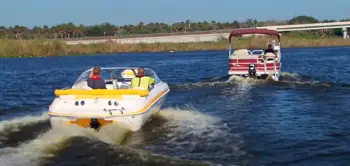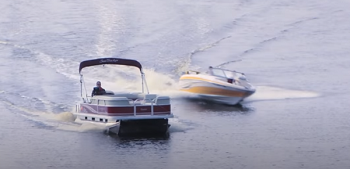One boat is overtaking another which boat should stand on? The overtaking boat is the stand-on boat and it can stop or slow down and let the other boat pass through.
Boating is a sport that many people enjoy, but it can be tough to figure out the navigation rules. In this blog post, I will cover one of the most common questions boaters have: One boat is overtaking another which one should stand on? Ans. – The overtaking boat is the give-way boat and the boat being overtaken is the stand-on boat.
One boat is overtaking another which boat should stand on?
In some cases, such as overtaking another in narrow channels where there’s not enough room for two boats side by side, both boats must give way and yield the right of way. However, if one boat is overtaking another in open water with plenty of room for both to go around each other then the boat being overtaken must stand on its course and speed, and the overtaking boat (give-away boat) must maneuver accordingly to pass safely.

The International Regulations for Preventing Collisions at Sea (Colregs) is a widely accepted set of rules for governing the safe operation of all vessels and applies to private recreational boaters as well as commercial vessels operating in foreign waters. One of the most important things about this international treaty is that it’s binding law in every country, including the United States. It describes what action any vessel should take when another vessel is approaching or overtaking.
What is a give-way boat?
One vessel is the give-way boat if she is required to take early and substantial action that involves a risk of collision. The give-way boat can slow down or stop, and sometimes even reverse if that will help get her out of the way. The give-way boat should be aware of her position and signaling capabilities relative to other vessels and adjust her speed accordingly. The give-way boat must consider a safe speed for a safe distance.
What is a stand-on boat?
One vessel is the stand-on boat if she is not required to take any action, and can continue on at her current speed and course. However, she is required to keep a good lookout and take action if the give-way boat does not comply with the rules. But the stand-on boat should avoid alteration of course into the path of the give-way boat if possible.
Sound signal for overtaking boat
You must sound one short blast on your whistle when you are overtaking another boat. One short blast is the signal for ‘I intend to overtake you on your starboard side. Two short blasts are the signal for ‘I intend to overtake you on your port side. The overtaken boat also sounds like one short blast after hearing your signal. One short blast means she agrees to you overtaking her on the right-hand side, and two short blasts mean she agrees to you overtaking her on the left-hand side.
Every boat shall carry an efficient sound-producing device such as a whistle, horn, or similar sound device capable of making the prescribed signals.
Head-on situation and rules of the road
In this situation, there is no stand-on boat. However, boaters must avoid alterations of course into the path of another vessel. Each shall alter her course to starboard and pass port to port in such a way as to be seen by the other, or as is required to avoid a collision.
Conclusion
It’s the law that a boat overtaking another shall keep out of the way. The give-way vessel (the one overtaking) has to take action, while it is up to the stand-on ship (being overtaken) to maintain vigilance in case she needs to avoid collision by taking appropriate avoiding action. If you find yourself on either end of this situation, know your rights under Colregs.

